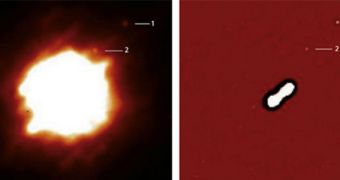Astronomers say that the asteroid Kleopatra is home to two twin moons, each of which is very small, yet noticeable using telescopes. The new discovery has important implications for the way we understand comets, experts add.
Until now, the debate on whether comets were solid objects or not has been raging on in the international astronomical community. This study provides additional evidence to support the theory that these large objects are in fact piles of space rubbish.
In other words, they are agglomerations of smaller space rocks, that are loosely bound together by gravity and other interactions. Scientists say that this is very important for understanding how these objects came to be, and how they developed when the solar system was still very young.
The two moons experts found around Kleopatra have been called Alexhelios and Cleoselene, after the twins that Egyptian queen Cleopatra – after which the space rock is named – birthed thousands of years ago. The conclusions experts arrived to in the research are based on studies of these objects.
The asteroid was tracked with a large number of both amateur and professional telescopes for a long time, as it passed between Earth and other stars. This allowed experts to study the object in detail.
Archived measurements, going back more than 30 years, were also used to augment the relevance of the discoveries, the investigators say. “That's the point of looking for triple and binary asteroids,” explains scientist Franck Marchis.
The expert, who is the coauthor of a new study detailing the findings, holds an appointment at the University of California in Berkeley (UCB), Space reports. “They're the only ones that allow us to measure the mass of the system,” he adds.
The mass of the asteroid and its moons was calculated by Observatoire de Paris (OP) Institut de Mecanique Celeste et de Calculs des Ephemerides (IMCCE) expert Pascal Descamps, the primary author of the new study.
“Our observations of the orbits of the two satellites of 216 Kleopatra imply that this large metallic asteroid is a rubble pile, which is a surprise,” Marchis says. Details of the study appear in the February issue of the esteemed journal Icarus, Space reports.

 14 DAY TRIAL //
14 DAY TRIAL //